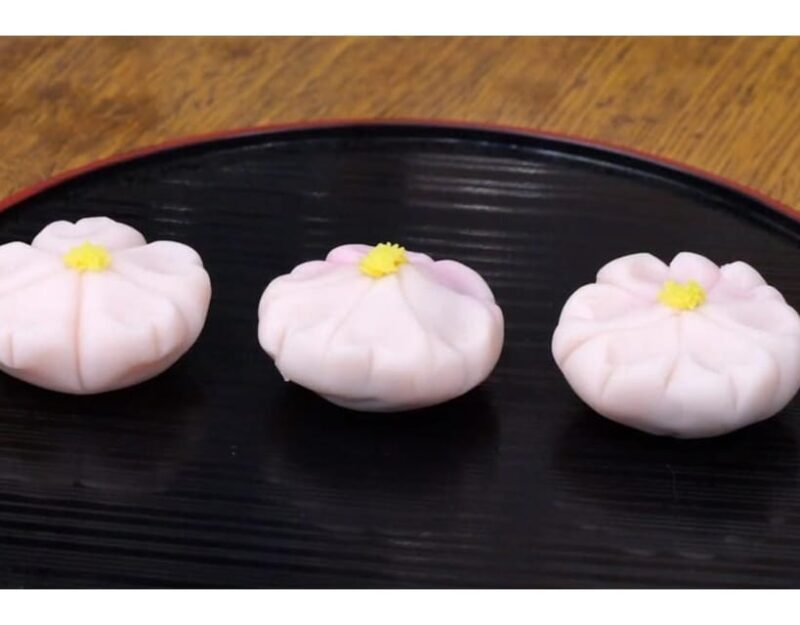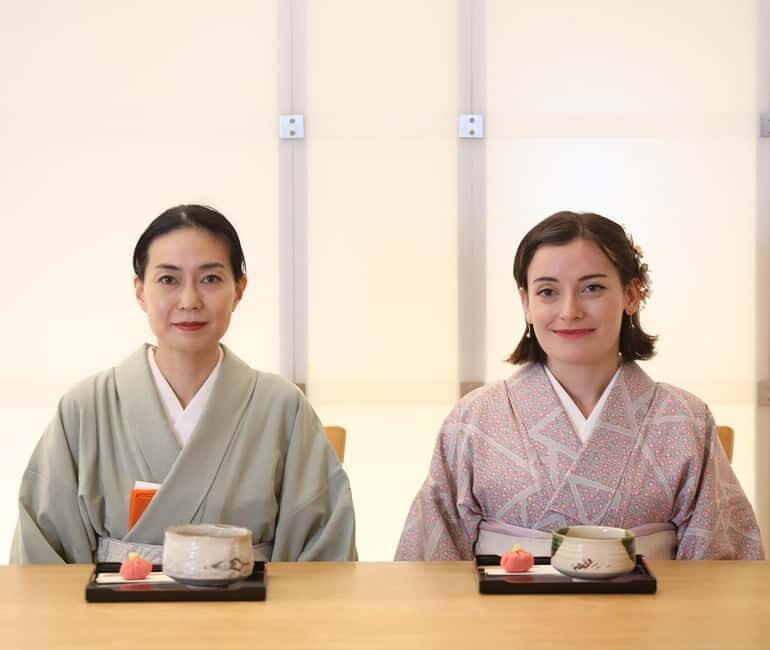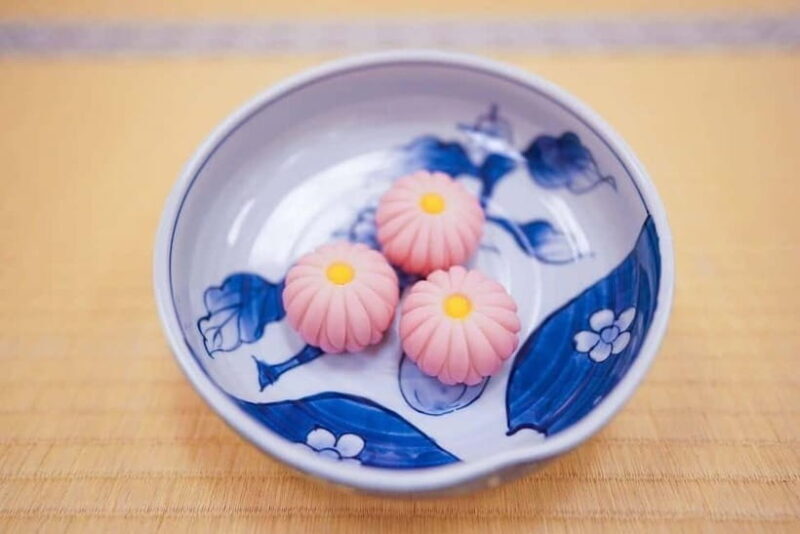Making Wagashi (Japanese sweets) at Tokyo’s Koboji Temple offers a rare chance to connect with Japan’s refined tea ceremony traditions in a stunning, authentic setting. For $74 per person, you’ll spend about an hour in an air-conditioned, 24-tatami-mat room within a historic temple, learning to craft nerikiri — the delicate, colorful sweets used in formal tea gatherings. Guided by knowledgeable hosts, you’ll also enjoy matcha green tea served in traditional style, making for a uniquely immersive cultural experience.
What we particularly love about this experience is how the hosts explain the significance of the sweets and the tea, bringing centuries of tradition to life in a way that’s engaging and accessible. The option to wear a kimono or a rare Oshima Tsumugi haori adds an elegant touch, transforming this from a simple workshop into a memorable photo opportunity. The venue itself, held in a peaceful temple, offers a tranquil backdrop that enhances the sense of stepping back in time.
A possible consideration is that the experience isn’t suitable for wheelchair users, so if accessibility is a priority, you’ll want to explore other options. But for those interested in authentic, hands-on Japanese culture — especially lovers of culinary arts, history, or traditional aesthetics — this tour hits the mark. It’s perfect for travelers seeking an intimate, educational activity that combines artistry with history and a dash of elegance.
Key Points

- Authentic Setting: Held in a historic, air-conditioned temple room with traditional tatami mats.
- Cultural Insight: Guides explain the significance of wagashi and matcha within Japanese tea ceremonies.
- Hands-On Activity: Learn to craft nerikiri, the main sweet used in tea ceremonies, with step-by-step guidance.
- Optional Kimono Experience: Dress in a kimono or Oshima Tsumugi haori for an extra special memory.
- Inclusion of Matcha: Enjoy traditional matcha served with the sweets, enhancing the culture.
- Limited Accessibility: Not suitable for wheelchair users but ideal for those interested in Japanese traditions.
A Detailed Look at the Experience

While in Tokyo, here are other experiences we've covered
Location and Atmosphere
The workshop takes place at Mita Koboji Temple, a serene historic site in Honshu, Japan. The temple’s atmosphere, combined with the traditional 24-tatami-mat room, instantly transports visitors to a different era. The room is kept cool and comfortable thanks to air conditioning, a detail that makes the experience more pleasurable during Japan’s warmer months. Many travelers have remarked on the venue’s beauty and calmness, creating a perfect environment for focusing on delicate crafts.
The Guided Process
Your experience is led by an experienced host who explains the significance of nerikiri, the main sweet of Japanese tea ceremonies. We loved the way the guide shares stories about the sweets’ origins and their role in Japanese culture, adding depth to what could otherwise be a simple craft session. The process involves kneading and shaping colorful dough into intricate shapes, much like playing with Play-Doh — a description that makes it sound more approachable than intimidating.
The Craftsmanship
Making nerikiri involves shaping white bean paste and glutinous rice flour into soft, pastel-colored designs. Participants often comment on how fun and relaxing it is, with one reviewer noting, “Making nerikiri was really fun, like playing with Playdoh!” The guided instructions ensure that even beginners can produce beautiful results, which you’ll be proud to show off later.
More Great Tours NearbyTea and Sweets
After the hands-on portion, the host presents the sweets and matcha, served in the traditional manner. The matcha is described as rich and flavorful, balancing the sweetness of the nerikiri. During this part, you’ll learn about the historical roots of the tea ceremony — a practice that dates back hundreds of years and was once regarded as the height of entertainment among samurai and aristocrats.
- Düsseldorf: Manga, mochi & more Düsseldorf’s Little Tokyo
- From Tokyo: Mt. Fuji Spanish & English Tour
- Downtown Los Angeles : Historic district & Little Tokyo
- Outdoor Escape Room in LA – Little Tokyo
- LA Little Tokyo to Olvera St Smartphone (App/GPS) Walking Tour
- 1-Day Mt Fuji and Hakone Sightseeing trip from Tokyo
Kimono or Haori Add-On
For an extra fee, you can don a kimono or the luxurious Oshima Tsumugi haori. The kimono master ensures you are dressed comfortably, which is perfect for photos and adds a layer of Japanese elegance to your day. Several reviewers have noted how this adds an unforgettable touch to the experience, transforming a simple workshop into a full culture.
Practical Details
The entire session lasts about 60 minutes, making it easy to fit into a busy sightseeing schedule. The experience is available in English and Japanese, with guides who are knowledgeable and friendly. You should arrive with comfortable clothes and bring a camera — though flash photography isn’t allowed, so be prepared to capture your memories without the flash.
Value and Booking
At $74, this experience offers a lot of value for those interested in Japanese arts and traditions. It’s especially appealing because it combines a creative activity, historical learning, and cultural ritual all in one. Booking is flexible, with the option to reserve now and pay later, which is convenient for planning trips.
Who Should Consider This Experience?

This activity is ideal for travelers with an interest in Japanese culture, history, or culinary arts. If you enjoy making things by hand or want a memorable photo op dressed in traditional kimono, you’ll find this workshop rewarding. It’s also a great choice for those who appreciate quiet, meaningful experiences rather than fast-paced sightseeing.
However, if mobility is a concern, be aware that this tour isn’t suitable for wheelchair users. Also, it’s best suited for those willing to sit comfortably on tatami mats — not recommended if you prefer more active or outdoor activities.
The Sum Up

Making wagashi at Tokyo’s Koboji Temple is a charming, authentic activity that offers more than just a hands-on craft experience. It provides a window into Japan’s cultural tapestry — from the delicate artistry of nerikiri to the centuries-old traditions of the tea ceremony. The serene temple setting, coupled with the guidance of friendly hosts, makes it an intimate and educational outing for curious travelers.
If you value cultural authenticity and enjoy learning about history through engaging activities, this tour will delight you. The optional kimono dressing adds a layer of elegance that makes for wonderful photos and keepsake memories. While not suited for all mobility levels, it’s an experience that rewards those who want to step beyond typical sightseeing and into the heart of Japanese tradition.
For anyone interested in a calm, beautiful, and meaningful cultural activity in Tokyo, this workshop offers genuine value and a memorable taste of Japan’s artistic spirit.
FAQ

Is this experience suitable for children?
While the activity involves shaping dough, it’s generally best suited for older children who can sit comfortably on tatami mats and understand the instructions. Check with the provider for age restrictions.
How long does the entire experience last?
The making session takes about 60 minutes, including guidance, making it a manageable activity within a day’s itinerary.
Can I participate if I don’t speak Japanese?
Yes, guides are available in English and Japanese, ensuring you can follow along and enjoy the explanations.
What should I wear?
Wear comfortable, casual clothes suitable for sitting on tatami mats. You might want to bring an apron if you prefer to keep your clothes clean.
Are there any physical restrictions?
This experience isn’t suitable for wheelchair users, as it requires sitting on the floor and handling delicate materials.
Is there an option to wear a kimono?
Yes, for an additional fee, you can dress in a kimono or the luxurious Oshima Tsumugi haori, which enhances the cultural feel and is perfect for photos.
Can I take pictures during the workshop?
You can take photos, but flash photography isn’t allowed to protect the delicate sweets and maintain the peaceful atmosphere.
What’s included in the price?
The fee covers the 60-minute sweets-making activity, guidance by an experienced host, the matcha green tea, and access to the authentic tatami room.
By choosing this experience, you’ll gain not only a new skill but also a deeper appreciation for Japan’s artistic traditions — all within a serene temple environment. Whether you’re a foodie, a history buff, or simply seeking a memorable cultural activity, this workshop offers genuine value and a chance for authentic connection.
You can check availability for your dates here:More Dessert Tours in Tokyo
- Japanese Sweets Making with Tea Ceremony in Private Studio
- Tokyo Local Food Tour: Noodles, Skewers, Dumplings, Sweets
- JPN Sweets & Sake Pairing after Old Tokyo Walk w/ a local guide
- Sakura Sweets Making & Tea Ceremony in Ikegami Plum Garden
- Best of Downtown Tokyo: Nature, Coffee, & Japanese Sweets Tasting
- Tokyo 6 h Private Guided Tour & Japanese Sweets Making Experience
More Tour Reviews in Tokyo
More Tokyo experiences we've covered
- Tokyo Sangenjaya Food & Drink Adventure
- Private Tokyo Ramen Tour
- Japanese Sweets Making with Tea Ceremony in Private Studio
- Hakone Private Two Day Tour from Tokyo with Overnight Stay in Ryokan
- Karate Experience with the Shotokan Karate-do Instructor
- Tokyo Small Group Tour with Guide
- Mt. Fuji View and 2hours+ free time at Gotemba Premium Outlets
- Mt. Fuji Skiing Experience- YETI Ski Resort & Onsen Day Trip
- Akihabara Tailor-made Private Tour for Anime Fans
- Tokyo Must See Top Hidden Gems In One Day
- Day Trip Matsushima by Bullet Train from Tokyo
- Nerikiri Wagashi-Making with Tea Ceremony
